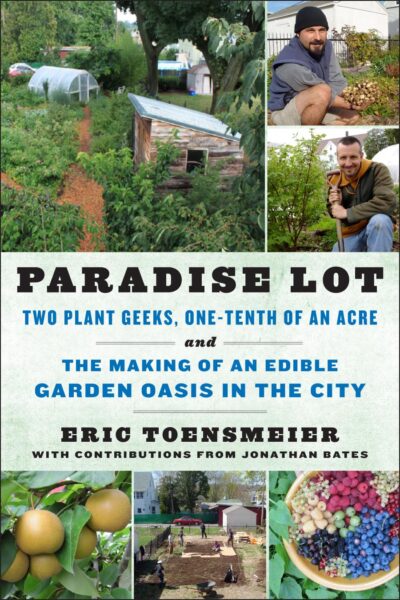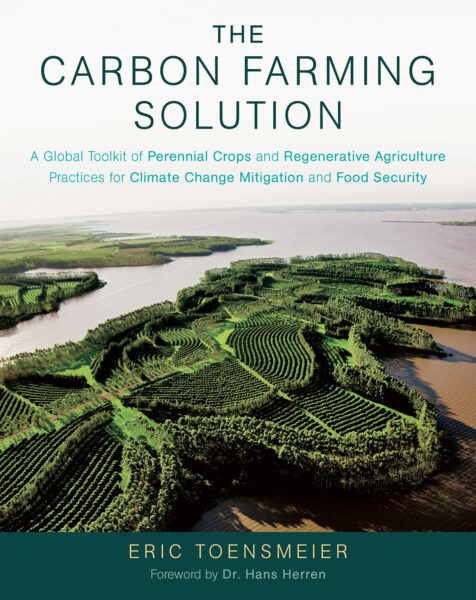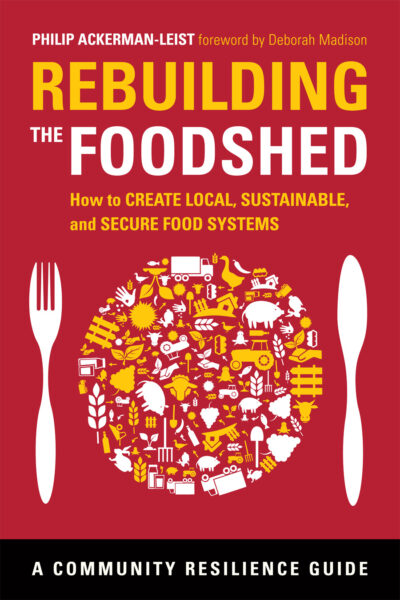Why Rebuilding Resilience Is As Important As Cutting Carbon Emissions
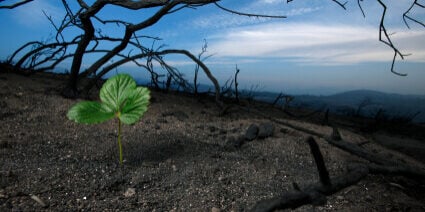
Learn how to practice resilience to become more self-sufficient and self-reliant in the future.
The following article has been adapted for the web from The Transition Handbook: From oil dependency to local resilience by Rob Hopkins.
What is resilience?
The concept of resilience is central to my book. In ecology, the term resilience refers to an ecosystem’s ability to roll with external shocks and attempted enforced changes. Walker et al. define it thus:
“Resilience is the capacity of a system to absorb disturbance and reorganise while undergoing change, so as to still retain essentially the same function, structure, identity and feedbacks.” 1
In the context of communities and settlements, it refers to their ability to not collapse at first sight of oil or food shortages, and to their ability to respond with adaptability to disturbance. The UK truck drivers’ dispute of 2000 offers a valuable lesson here. Within the space of three days, the UK economy was brought to the brink, as it became clear that the country was about a day away from food rationing and civil unrest.
Shortly before the dispute was resolved, Sir Peter Davis, Chairman of Sainsbury’s, sent a letter to Tony Blair saying that food shortages would appear in “days rather than weeks”.2 The fragility of the illusion that, as DEFRA said in a 2003 statement, “national food security is neither necessary nor is it desirable,” 3 became glaringly obvious. It became clear that we no longer have any resilience left to fall back on, and are, in reality, three days away from hunger at any moment, evoking the old saying that “civilisation is only three meals deep”. We have become completely reliant on the utterly unreliable, and we have no Plan B.
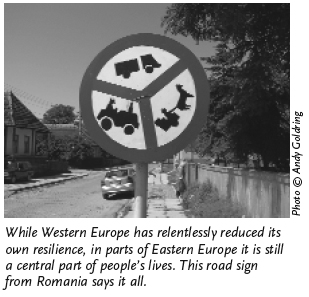
The concept of resilience goes far beyond the better-known concept of sustainability. A community might, for example, campaign for plastics recycling, where all of its industrial and domestic plastic waste is collected for recycling. While almost certainly being better for the environment as a whole, it adds almost no resilience to the community. Perhaps a better solution (alongside the obvious one of producing less plastic waste), would be to develop other uses for waste plastics requiring minimal processing, perhaps producing tightly compressed building blocks or an insulating product for local use. Simply collecting it and sending it away doesn’t leave the community in a stronger position, nor is it more able to respond creatively to change and shock. The same is true of some of the strategies put forward by climate change campaigns that don’t take peak oil into consideration. Planting trees to create community woodlands may lock up carbon (though the science is still divided on this) and be good for biodiversity, but does little to build resilience; whereas the planting of well-designed agroforestry/food forest plantings does. The Millennium Forests initiative missed a huge opportunity to put in place a key resource: we could by now have food forests up and down the country starting to bear fruit (both metaphorically and literally).
Economist David Fleming argues that the benefits for a community with enhanced resilience will be that:
• If one part is destroyed, the shock will not ripple through the whole system
• There is wide diversity of character and solutions developed creatively in response to local circumstances
• It can meet its needs despite the substantial absence of travel and transport
• The other big infrastructures and bureaucracies of the intermediate economy are replaced by fit-for-purpose local alternatives at drastically reduced cost 4
Increased resilience and a stronger local economy do not mean that we put a fence up around our towns and cities and refuse to allow anything in or out. It is not a rejection of commerce or somehow a return to a rose-tinted version of some imagined past. What it does mean is being more prepared for a leaner future, more self-reliant, and prioritising the local over the imported.
The three ingredients of a resilient system
According to studies of what makes ecosystems resilient,5 there are three features that are central to a system’s ability to reorganise itself following shocks. They are:
• Diversity
• Modularity
• Tightness of Feedbacks
Diversity relates to the number of elements that comprise a particular system, be they people, species, businesses, institutions or sources of food. The resilience of a system comes not only from the number of the species that make up that diversity, but also from the number of connections between them. Diversity also refers to the diversity of functions in our settlements (rather than just relying on one – say, tourism or mining) and a diversity of potential responses to challenges, leading to a greater flexibility. Diversity of land use – farms, market gardens, aquaculture, forest gardens, nut tree plantings, and so on – are key to the resilience of the settlement, and their erosion in recent years has paralleled the rise of monocultures, which are by definition an absence of diversity.6
Another meaning of diversity is that of diversity between systems. The exact set of solutions that will work in one place will not necessarily work in other places: each community will assemble its own solutions, responses and tools. This matters for two reasons. Firstly because it makes top-down approaches almost redundant, as those at the top lack the knowledge of local conditions and how to respond to them. Secondly, because resilience-building is about working on small changes to lots of niches in the place, making lots of small interventions rather than a few large ones.7
The term modularity, according to ecologists Brian Walker and David Salt, relates to “the manner in which the components that make up a system are linked”.8 Towards the end of 2007, the Northern Rock bank crisis led to major problems and uncertainty in the British banking system. It was caused by over-lending to high-risk house-buyers in the US thousands of miles away, but within a short period of time one system had knocked on to another and then another, showing how the globalised networks, often trumpeted as one of globalisation’s great strengths, can in fact also be one of its great weaknesses. The over-networked nature of modern, highly connected systems allow shock to travel rapidly through them, with potentially disastrous effects.
A more modular structure means that the parts of a system can more effectively self-organise in the event of shock. For example, as a result of the globalisation of the food industry, animals and animal parts are moved around the world, leading to increased occurrences of diseases such as bird flu and foot-and-mouth disease. Reducing animal transportation and reintroducing local abattoirs and processing would lead to a more modular system, with local breeds for local markets and a much reduced risk of disease spreading with the rapidity that we have seen in recent outbreaks.
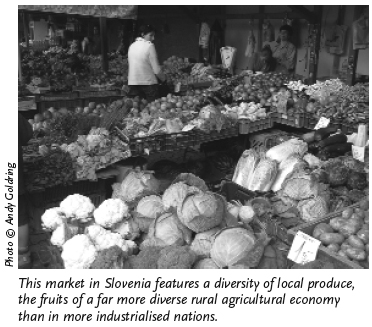
When designing energy descent pathways for Transition Initiatives, the concept of modularity is key: maximising modularity with more internal connections reduces vulnerability to any disruptions of wider networks. Local food systems, local investment models, and so on, all add to this modularity, meaning that we engage with the wider world but from an ethic of networking and information sharing rather than of mutual dependence.
Tightness of Feedbacks refers to how quickly and strongly the consequences of a change in one part of the system are felt and responded to in other parts. Walker and Salt write: “Centralised governance and globalisation can weaken feedbacks. As feedbacks lengthen, there is an increased chance of crossing a threshold without detecting it in a timely fashion.” 9 In a more localised system, the results of our actions are more obvious. We don’t want excessive use of pesticides or other pollutants in our area, but seem happier to be oblivious to their use in other parts of the world. In a globalised system, the feedbacks about the impacts of soil erosion, low pay and pesticide use provide weak feedback signals. Tightening feedback loops will have beneficial results, allowing us to bring the consequences of our actions closer to home, rather than their being so far from our awareness that they don’t even register. When people live off the grid in terms of energy, they are more mindful about their consumption because they are closer to its generation – the feedback loop is smaller.
Resources
- Walker, B, Hollinger, C.S., Carpenter, S.R. and Kinzig, A. (2004) ‘Resilience, Adaptability and Transformability in Social-ecological Systems’, Ecology and Society 9 (2) p.5.
- For a more detailed overview of the lorry drivers’ dispute, see Strahan, D. (2007) The Last Oil Shock: A Survival Guide to the Imminent Extinction of Petroleum Man, John Murray.
- Department of Environment, Food and Rural Affairs. Press statement released at the 2003 Royal Show.
- Fleming, D. (2007) Lean Logic, a Dictionary of Environmental Manners. Unpublished MS.
- For example Levin, S. A. (1999) Fragile Dominion, Perseus Books Group.
- For a thorough demolition of the concept of monoculture, see Shiva, V. (1998) Monocultures of the Mind: Biodiversity, Biotechnology and Scientific Agriculture, Zed Books.
- Thanks to David Fleming for identifying these two points in an email exchange.
- Walker, B. & Salt, D. (2007) Resilience Thinking: Sustaining Ecosystems and People in a Changing World, Island Press.
- Ibid. p.121.
Recent Articles
For too long, bugs have had a negative connotation associated with them. But what if we took the time to observe the benefits of insects? It’s time to rebug our gardens, lawns, and parks! The following is an excerpt from Rebugging the Planet by Vicki Hird. It has been adapted for the web. Adding Bugs:…
Read MoreAsparagus is a delicious vegetable with a layered history. How did this aspiring spear make its way from growing in the wild to appearing on our plates? The following is an excerpt from the The Seed Detective by Adam Alexander. It has been adapted for the web. “Nature gives us the key to every secret…
Read MoreChances are, you’ve seen cattails growing on the edge of your local lake or stream at least once or twice. Instead of just passing these plants, try foraging for and cooking them to create delicious seasonal dishes! The following excerpt is from The New Wildcrafted Cuisine by Pascal Baudar. It has been adapted for the…
Read MoreGarlic mustard: while known as “invasive,” this plant can be consumed in its entirety and has great nutritional value. Plus, the garlic-flavor is a perfect addition to any recipe that calls for mustard! The following are excerpts from Beyond the War on Invasive Species by Tao Orion and The Wild Wisdom of Weeds by Katrina…
Read MorePeregrine falcons, while known as predators, are essential to our environment. These stunning birds have a rich history, an interesting present, and an uncertain future. The following is an excerpt from Feather Trails by Sophie A. H. Osborn. It has been adapted for the web. Who Are Peregrine Falcons? Though relatively uncommon wherever it occurs,…
Read More

